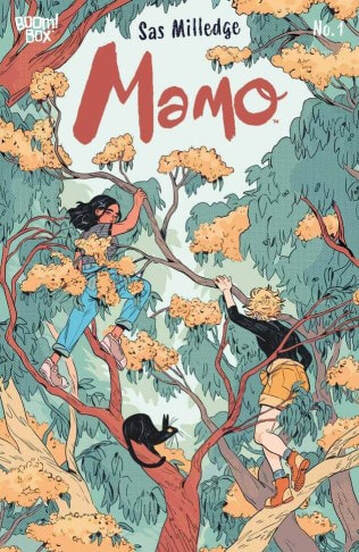|
Mamo #1-3 (of 5?). By Sas Milledge. BOOM! Studios / BOOM! Box. July-September, 2021. $US 4.99 per issue. 44-56 pages each. I don't ordinarily review periodical comic books, in the sense of single issues aimed at the direct market, on KinderComics, especially when the stories are still in progress, but for Mamo I must make an exception. Sure, this fantasy about two young women sharing magic and solving problems together is yet another witch-themed story for young readers (of the type I've been covering lately, here, here, here, here, and here). Sure, its storyworld and its visuals are decidedly Miyazaki-esque, with particular nods, I think, to Miyazaki's versions of Kiki's Delivery Service and Howl's Moving Castle. Genre-wise, this has become familiar territory: I'm convinced that Hayao Miyazaki is the key to much of what is happening in contemporary fantasy comics (see for example my comments on Mark Siegel and company's 5 Worlds or Tillie Walden's Are You Listening?). I see many homages to his work even when attending small-press festivals. In that sense, Mamo is not new. But Melbourne-based artist Sas Milledge really delivers the goods here. This is a nuanced, breathtakingly beautiful story, with smart, insinuating characterization, a deliberate, thought-through, but not mechanical approach to magic, and a healthy respect for mystery, both the secrets of the heart and of the world. It really is something, and I can't wait to read it to the end. I won't go into detail here (I expect to come back to Mamo when it is collected), but, briefly, the story takes place in and around an agrarian village, a place that may coexist with the modern world yet seems firmly preindustrial and bucolic. The setting seems vaguely European, ambiguously Irish or Scandinavian or Nordic (with perhaps a nod to Finland's Tove Jansson). But the ambiguity may be important. Protagonist Joanna Manalo, or Jo, is a Filipina. Her co-protagonist, the book's leading witch, boasts an Irish name, Orla O'Reilly. Their village includes a variety of people. Jo and Orla's relationship is the mainspring of the plot: Jo enlists Orla's aid to counteract a seeming spell or curse that overlies the village. Orla's grandmother, the Mamo of the title, once served as the village witch but seems to have died, while yet leaving behind traces of herself that contain powerful and vexatious magic. Jo and Orla must travel round the village and environs to find spots haunted by Mamo, spots of weirdness and trouble that need to be calmed. So far, Mamo is less a character than the precondition of the whole story, but exactly why her spirit is still unsettled remains a mystery, as does the nature of Orla's seemingly ambivalent relationship to her grandmother. As Orla and Jo circle round the village, marking a map to chart their progress, the two women develop a wary yet increasingly warm friendship (and perhaps something more?), and each reveals secrets. Two things really impress me about Mamo. One is the sense of atmosphere conveyed by Milledge's gorgeously colored pages (produced in collaboration with color flatter Belle Murdoch). The environments here remind me of Kazuo Oga's beautiful art direction and backgrounds for various Studio Ghibli films, including many of Miyazaki's: My Neighbor Totoro, Kiki, and so on. The mingled colors and shadows, the play of shadow over color and over forms, results in a transporting loveliness. Even the darkest moments are dappled with filtered sunlight, a delicious effect that Milledge can't seem to get enough of. I'm reminded of Tillie Walden's bold way with colors, as well as, of course, the quietly lovely countryside of Totoro. The other thing that gets me is, again, Milledge's understanding of magic. Mamo has its own theory or philosophy of magic, which emphasizes giving, accepting, and mutuality: the sharing of power (power shared is power doubled). Magic means relationships, and that means constraints and obligations, not just unbridled power. Favors and connections are everything. The idea that magic comes with obligations and limits isn't new (I picked something like this up from reading Le Guin's Earthsea, long ago). But Milledge seems to have thought this issue over very carefully. Logically, her philosophy of magic provides the ideal setting for the story of a budding relationship; really, the relationship and the magic are the same thing. I get the feeling that magic, in Mamo, is a meaningful system built out of mutual regard and strong feeling. All this is conveyed without pedantry or tedious exposition. Many fantasy writers have tried to work out a system of magic that preserves a sense of mystery and wonder without giving way to an anything-goes sort of sloppiness. Milledge does this better than most, the result being a very grounded, though no less wondrous, type of fantasy. Mamo is the kind of comic book that overcomes my habit of trade-waiting: a floppy series that compels me to break down and just buy the next issue, already! A warmly humanistic, implicitly queer-positive, inclusive fantasy, it's also an aesthetic delight. I recommend checking it out.
0 Comments
|
Archives
June 2024
|



 RSS Feed
RSS Feed
